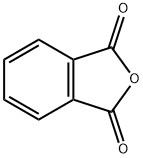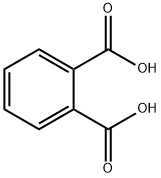o-Phthalic anhydride , ACS , 85-44-9
Synonym(s):
Phthalic anhydride
CAS NO.:85-44-9
Empirical Formula: C8H4O3
Molecular Weight: 148.12
MDL number: MFCD00005918
EINECS: 201-607-5
PRODUCT Properties
| Melting point: | 131-134 °C(lit.) |
| Boiling point: | 284 °C(lit.) |
| bulk density | 500-700kg/m3 |
| Density | 1,53 g/cm3 |
| vapor density | 5.1 (vs air) |
| vapor pressure | <0.01 mm Hg ( 20 °C) |
| refractive index | 1.4500 (estimate) |
| Flash point: | 152 °C |
| storage temp. | Store below +30°C. |
| solubility | 6g/l (slow decomposition) |
| form | Flaky Crystals |
| pka | 2.97[at 20 ℃] |
| color | White |
| Odor | Characteristic choking odor |
| PH Range | 2 at 6 g/l at 20 °C |
| PH | 2 (6g/l, H2O, 20℃) |
| explosive limit | 1.7-10.5%(V) |
| Water Solubility | 6 g/L (20 ºC) |
| Sensitive | Moisture Sensitive |
| Merck | 14,7372 |
| BRN | 118515 |
| Henry's Law Constant | 6.29 at 20 °C (approximate - calculated from water solubility and vapor pressure) |
| Exposure limits | NIOSH REL: TWA 6 mg/m3 (1 ppm), IDLH 60 mg/m3; OSHA PEL: TWA 12
mg/m3 (2 ppm); ACGIH TLV: TWA 1 ppm (adopted). |
| Stability: | Stable. Combustible. Incompatible with strong oxidizing agents, strong bases, moisture, strong acids. Dust may form an explosive mixture with air. |
| LogP | 2.07 at 20℃ |
| CAS DataBase Reference | 85-44-9(CAS DataBase Reference) |
| NIST Chemistry Reference | Phthalic anhydride(85-44-9) |
| EPA Substance Registry System | Phthalic anhydride (85-44-9) |
Description and Uses
Phthalic anhydride is the organic compound with the formula C6H4(CO)2O. It is the anhydride of phthalic acid. This colourless solid is an important industrial chemical, especially for the large-scale production of plasticizers for plastics.
Phthalic anhydride is an important chemical intermediate in the plastics industry from which are derived numerous phthalate esters that function as plasticizers in synthetic resins. Phthalic anhydride itself is used as a monomer for synthetic resins such as glyptal, the alkyd resins, and the polyester resins.
Phthalic anhydride is also used as a precursor of anthraquinone, phthalein, rhodamine, phthalocyanine, fluorescein, and xanthene dyes.
Phthalic anhydride is used in the synthesis of primary amines, the agricultural fungicide phaltan, and thalidomide. Other reactions with phthalic anhydride yield phenolphthalein, benzoic acid, phthalylsulfathiazole (an intestinal antimicrobial agent), and orthophthalic acid.
Phthalic anhydride is used in the manufacture of unsaturated polyesters and as a curing agent for epoxy resins. When used as a pigment, it can be responsible for sensitization in ceramic workers.
Safety
| Symbol(GHS) |    GHS05,GHS07,GHS08 |
| Signal word | Danger |
| Hazard statements | H302-H315-H317-H318-H334-H335 |
| Precautionary statements | P280-P301+P312+P330-P302+P352-P305+P351+P338+P310 |
| Hazard Codes | Xn |
| Risk Statements | 22-37/38-41-42/43 |
| Safety Statements | 23-24/25-26-37/39-46-22 |
| RIDADR | 2214 |
| OEB | B |
| OEL | TWA: 6 mg/m3 (1 ppm) |
| WGK Germany | 1 |
| RTECS | TI3150000 |
| F | 10-21 |
| Autoignition Temperature | 580 °C |
| TSCA | Yes |
| HazardClass | 8 |
| PackingGroup | III |
| HS Code | 29173500 |
| Hazardous Substances Data | 85-44-9(Hazardous Substances Data) |
| Toxicity | LD50 orally in Rabbit: 1530 mg/kg LD50 dermal Rabbit > 3160 mg/kg |
| IDLA | 60 mg/m3 |



